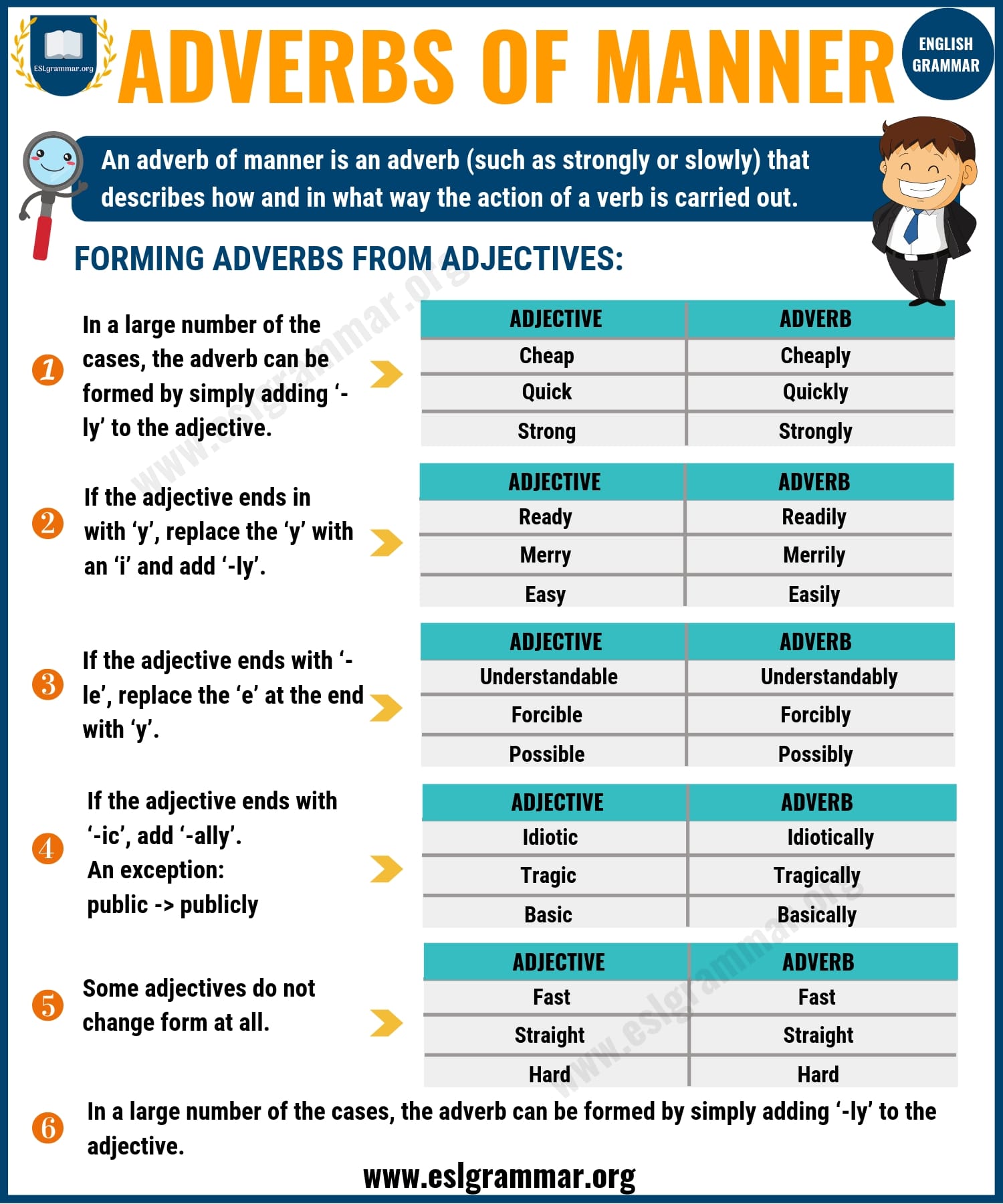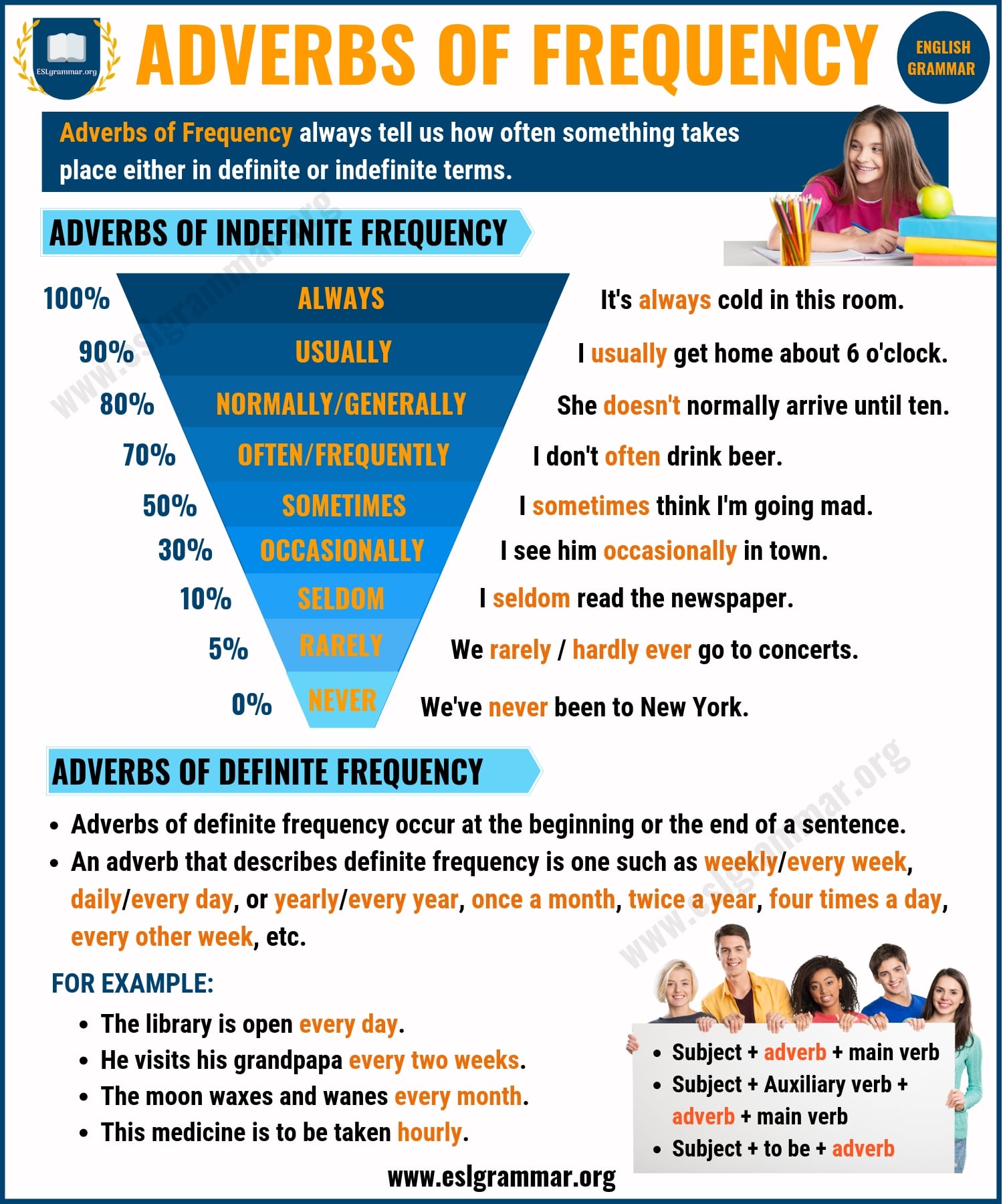Make Adverbs Great Again Not Working
Adverbs in English! What is an adverb? Learn different types of adverbs and how to utilize them in English sentences with useful examples, practical exercises and gratuitous ESL printable infographic.
Adverb Definition
What is an Adverb?
Adverbs are words that are used in sentences to depict or alter the meaning of a Verb or Adjective or even another Adverb. They add a description to the judgement to brand it more detailed and interesting. For example:
- He walked slowly across the square.
Here, one tin can see that the Adverb 'slowly' is describing the Verb 'walk' by telling that the person was walking slowly.
Types of Adverbs
Adverbs are used in sentences to answer many questions almost the Verbs/Adjectives/Adverbs themselves. The different types of Adverbs are as following:
Adverb of Time
What is an adverb of time? Look at examples below:
E.grand.: The results were announced yesterday.
Here the Adverb is yesterday which is answering the question: When were the results announced? 'Announced' is the verb in this sentence.
Eastward.g.: She will visit the infirmary tomorrow.
Here the Verb is 'visit' and the Adverb is tomorrow as the question being asked is: When will she visit the infirmary?
Other examples of Adverbs of Time are – Once, Never, Tomorrow, Daily, etc.
Adverb of Place
What is an adverb of place? Look at examples below:
E.thousand.: They will meet y'all there.
The Adverb here is there that is specifying a place for the Verb meet and the question being answered is: Where will they come across you?
E.g.: In spring, flowers bloom everywhere.
Here the Verb is bloom and the Adverb is everywhere, answering the question: Where do the flowers flower in spring?
Other examples of Adverbs of Place are – Anywhere, Somewhere, Nigh, Far, etc.
Adverb of Fashion
What is an adverb of manner? Expect at examples below:
Eastward.g.: He quietly slipped abroad.
The Adverb here is quietly which is telling the manner or manner in which the action was carried out and the Verb is slipped which is telling: How did he slip abroad.
Due east.one thousand.: She works fast.
The Verb here is piece of work and the Adverb is fast and the question being asked is: How does she work?
These Adverbs tell about the manner of the action being done, whether it is done happily or haltingly etc. Other examples of Adverbs of Way are – Honestly, Joyfully, Cunningly, etc.
Types of Adverbs – Adverbs of Manner | Epitome
Adverb of Frequency
What are adverbs of frequency? Allow take a expect at those examples below:
E.g.: He likes to sentry TV every mean solar day.
Hither, the Adverb is every mean solar day and it is telling well-nigh the amount of time spent in doing the Verb, which is sentry. The question in this sentence is: How often does he sentinel Television receiver?
E.g.: They meet every calendar week.
The Adverb here is every week and it is telling the frequency and the Verb is run across. The sentence is telling us: How oftentimes do they encounter?
These Adverbs are used to bear witness the elapsing or timing of the action that is happening/had happened/will happen. They likewise tell united states of america how oftentimes and how long these actions would be.
Other examples of Adverbs of Frequency are – Ofttimes, Frequently, Yearly, Briefly, etc.
Adverbs of Frequency | Image
Adverbs of Caste
E.thousand.: She almost finished the piece of work.
The Verb here is finished and the Adverb is almost which is telling us near the amount of the work finished. The question being asked is: How much of the work did she stop?
E.g.: They were completely surprised by the windfall.
The adverb here is completely which is showing the degree to which 'they' were surprised which is the Verb. The question being asked here is: How much were they surprised?
The Adverbs of Degree are used to show to what extent or how much has an activeness been done or will exist done.
Other examples of these Adverbs are – Fully, Partially, Altogether, etc.
Adverbs of Confirmation and Negation
E.g.: They volition certainly similar this vase.
The Adverb here is certainly which is reinforcing the Verb like in answer to the question: Will they like this vase?
East.g.: He never leaves his house.
The Adverb never is negating the Verb leave. Information technology is answering the question in deprival: Does he ever leave his house?
These Adverbs either confirm or deny the activeness of the Verb. They are also used to reinforce the activeness that is described by the Verb.
Other examples of Adverbs of Confirmation are – Definitely, Absolutely, Surely, etc. Examples for Adverbs of Denial or Negation are – No, Don't, Can't, etc.
Adverbs of Annotate
These Adverbs are used to make a comment on the unabridged sentence. They give a look at the speaker'due south viewpoint or opinion about the sentence. These Adverbs don't but change or describe the Verb; they influence the whole sentence.
They constitute his secret easily.
+
Unfortunately
Unfortunately, they found his hole-and-corner easily.
Here, we see that calculation the Adverb, unfortunately, has changed the unabridged tone of the sentence. Earlier, it was a passive tone, now it has a negative or disappointed tone.
Other examples of Adverbs of Annotate are:
- Luckily, the domestic dog did not bite the children.
- Happily, the power returned before the big lucifer.
- Did hehonestlyexpect me to lie for him? (Adverb adds comment on the anger of the speaker.)
- And they would win the earth cup,obviously. (Can exist said in a sarcastic likewise every bit positive manner)
Adverbs of Conjunction
What are adverbs of conjunction?
These Adverbs are used to connect ideas or clauses, they are used to show consequence or outcome or the relation between the two clauses. To use these Adverbs to conjugate two clauses you need to employ a semicolon (;) to connect them.
Clause ane: He was going for an of import interview.
Clause ii: He made sure he reached on fourth dimension.
He was going for an important interview; appropriately, he made sure he reached on time.
Here, nosotros see how the Adverb 'accordingly' is joining the two clauses and showing the relation between them with the apply of a semicolon (;). Accordingly ways- therefore or that is why.
A few other Adverbs of Conjunction are:
- All the same – Still, on the other manus, in spite of
- Consequently – As a consequence, resulting in
- Moreover – Beside, in improver
- Conversely – Reverse of, contrary to
Position of Adverbs
What is the correct place to put an adverb in English sentences?
Adverbs can be used in diverse ways, which means that they are very flexible in sentences; they tin can exist moved around quite a chip without causing whatsoever grammatical irregularities.
Adverbs are used to begin sentences/clauses
- I did not care for her tone.However, I let it go.
- Tomorrow I am leaving for Calcutta.
Adverbs are used in the centre of sentences
- Yous areever belatedly.
- I willprobably be absent-minded at the political party.
Adverbs are used to at the stop of sentences
- He wrote the answerscorrectly.
- His stammer acquired him to speakhaltingly.
- …
Position of Adverbs | Image
Types of Adverbs | Infographic
8 Common Types of Adverbs in English | Epitome
Source: https://eslgrammar.org/adverbs/




0 Response to "Make Adverbs Great Again Not Working"
Post a Comment